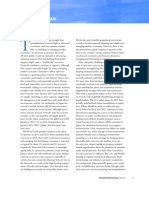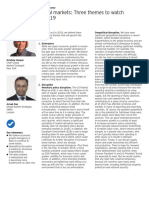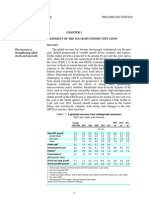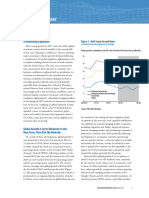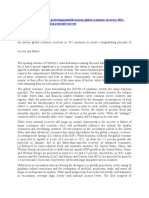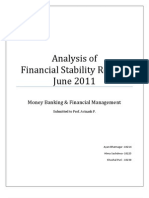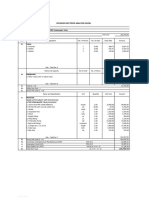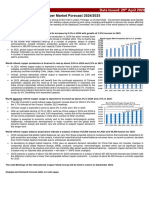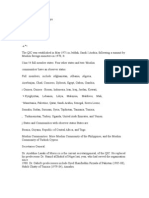Foreword
Foreword
Uploaded by
5gny4dfrqzCopyright:
Available Formats
Foreword
Foreword
Uploaded by
5gny4dfrqzOriginal Title
Copyright
Available Formats
Share this document
Did you find this document useful?
Is this content inappropriate?
Copyright:
Available Formats
Foreword
Foreword
Uploaded by
5gny4dfrqzCopyright:
Available Formats
FOREWORD
Global Economy Remains Resilient despite Resilient growth and faster disinflation point
Uneven Growth; Challenges Lie Ahead toward favorable supply developments, including
The global economy remains remarkably resil- the fading of earlier energy price shocks, the striking
ient, with growth holding steady as inflation returns rebound in labor supply supported by strong immi-
to target. The journey has been eventful, starting gration flows in many advanced economies. Decisive
with supply-chain disruptions in the aftermath of monetary policy actions, as well as improved mone-
the pandemic, a Russian-initiated war on Ukraine tary policy frameworks, especially in emerging market
that triggered a global energy and food crisis, and a economies, have helped anchor inflation expecta-
considerable surge in inflation, followed by a globally tions. As Chapter 2 of this report argues, however,
synchronized monetary policy tightening. the transmission of monetary policy may have been
Yet, despite many gloomy predictions, the world more muted this time around in countries such as the
avoided a recession, the banking system proved largely United States, where an increased share of fixed-rate
resilient, and major emerging market economies mortgages and lower household debt levels since the
did not suffer sudden stops. Moreover, the inflation global financial crisis may have limited the drag on
surge—despite its severity and the associated cost-of- aggregate demand up to now.
living crisis—did not trigger uncontrolled wage-price Despite these welcome developments, numerous
spirals (see October 2022 World Economic Outlook). challenges remain, and decisive actions are needed.
Instead, almost as quickly as global inflation went up, First, while inflation trends are encouraging, we
it has been coming down. are not there yet. Somewhat worryingly, the most
On a year-over-year basis, global growth bottomed recent median headline and core inflation numbers are
out at the end of 2022, at 2.3 percent, shortly after pushing upward. This could be temporary, but there
median headline inflation peaked at 9.4 percent. are reasons to remain vigilant. Most of the progress on
According to our latest projections, growth for 2024 inflation came from the decline in energy prices and
and 2025 will hold steady around 3.2 percent, with goods inflation below its historical average. The latter
median headline inflation declining from 2.8 percent has been helped by easing supply-chain frictions, as
at the end of 2024 to 2.4 percent at the end of 2025. well as by the decline in Chinese export prices. But
Most indicators point to a soft landing. services inflation remains high—sometimes stubbornly
Markets reacted exuberantly to the prospect of cen- so—and could derail the disinflation path. Bringing
tral banks exiting from tight monetary policy. Financial inflation down to target remains the priority.
conditions eased, equity valuations soared, capital flows Second, the global view can mask stark divergence
to most emerging market economies excluding China across countries. The exceptional recent performance
have been buoyant, and some low-income countries of the United States is certainly impressive and a major
and frontier economies regained market access (see the driver of global growth, but it reflects strong demand
April 2024 Global Financial Stability Report). factors as well, including a fiscal stance that is out of
Even more encouraging, we now estimate that line with long-term fiscal sustainability (see April 2024
there will be less economic scarring from the Fiscal Monitor). This raises short-term risks to the
pandemic—the projected drop in output relative disinflation process, as well as longer-term fiscal and
to prepandemic projections—for most countries financial stability risks for the global economy since it
and regions, especially for emerging market econo- risks pushing up global funding costs. Something will
mies, thanks in part to robust employment growth. have to give.
Astonishingly, the US economy has already surged In the euro area, growth will pick up this year, but
past its prepandemic trend. from very low levels, as the trailing effects of tight
International Monetary Fund | April 2024 xiii
WORLD ECONOMIC OUTLOOK—Steady but Slow: Resilience amid Divergence
monetary policy and past energy costs, as well as Third, even as inflation recedes, real interest rates
planned fiscal consolidation, weigh on activity. Contin- have increased, and sovereign debt dynamics have
ued high wage growth and persistent services inflation become less favorable in particular for highly indebted
could delay the return of inflation to target. However, emerging markets. Countries should turn their sights
unlike in the United States, there is scant evidence of toward rebuilding fiscal buffers. Credible fiscal consoli-
overheating and the European Central Bank will also dations help lower funding costs and improve financial
need to carefully calibrate the pivot toward monetary stability. In a world with more frequent adverse supply
easing to avoid an excessive growth slowdown and shocks and growing fiscal needs for safety nets, climate
inflation undershoot. While labor markets appear adaptation, digital transformation, energy security,
strong, that strength could prove illusory if European and defense, this should be a policy priority. Yet this is
firms have been hoarding labor in anticipation of a never easy, as the April 2023 World Economic Outlook
pickup in activity that does not materialize. documented: fiscal consolidations are more likely to
China’s economy is affected by the enduring down- succeed when credible and when implemented while
turn in its property sector. Credit booms and busts the economy is growing, rather than when markets
never resolve themselves quickly, and this one is no dictate their conditions. In countries where inflation is
exception. Domestic demand will remain lackluster under control, and that engage in a credible multiyear
for some time unless strong measures and reforms effort to rebuild fiscal buffers, monetary policy can
address the root cause. Public debt dynamics are also help support activity. The successful 1993 US fiscal
of concern, especially if the property crisis morphs into consolidation and monetary accommodation episode
a local public finance crisis. With depressed domestic comes to mind as an example to emulate.
demand, external surpluses could rise. The risk is that Fourth, medium-term growth prospects remain
this will further exacerbate trade tensions in an already historically weak. Chapter 3 of this report takes an
fraught geopolitical environment. in-depth dive into the different drivers of the slow-
At the same time, many other large emerging down. The main culprit is lower total factor pro-
market economies are performing strongly, sometimes ductivity growth. A significant part of the decline
even benefiting from a reconfiguration of global supply comes from increased misallocation of capital and
chains and rising trade tensions between China and the labor within sectors and countries. Facilitating faster
United States. As Chapter 4 of this report documents, and more efficient resource allocation can help boost
these countries’ footprint on the global economy is growth. Much hope rests on artificial intelligence (AI)
increasing, and they will play an ever larger role in delivering strong productivity gains in the medium
supporting global growth in years to come. term. It may do so, but the potential for serious
A troubling development is the widening divergence disruptions in labor and financial markets is high.
between many low-income developing countries and Harnessing the potential of AI for all will require that
the rest of the world. For these economies, growth countries improve their digital infrastructure, invest
is revised downward, whereas inflation is revised up. in human capital, and coordinate on global rules of
Worse, in contrast with most other regions, scarring the road. Medium-term growth prospects are also
estimates for low-income developing countries, includ- harmed by rising geoeconomic fragmentation and the
ing some large ones, have been revised up, suggesting surge in trade restrictive and industrial policy mea-
that the poorest countries are still unable to turn the sures since 2019. Global trade linkages are already
page from the pandemic and cost-of-living crises. In changing as a result, with potential losses in efficiency.
addition, conflicts continue to result in loss of human But the broader damage is to global cooperation and
lives and raise uncertainty. For these countries, invest- multilateralism.
ing in structural reforms to promote growth-enhancing Finally, huge global investments are needed for a
domestic and foreign direct investment, and strength- green and climate-resilient future. Cutting emissions
ening domestic resource mobilization, can help is compatible with growth, as is seen in recent decades
manage borrowing costs and reduce funding needs during which growth has become much less emis-
while achieving development goals. Efforts must also sions intensive. Nevertheless, emissions are still rising.
be made to improve the human capital of their large A lot more needs to be done and done quickly. Green
young populations. investment has expanded at a healthy pace in advanced
xiv International Monetary Fund | April 2024
FOREWORD
economies and China. Cutting harmful fossil fuel financing, much of it from the private sector, but some
subsidies can help create the necessary fiscal room for of it concessional.
further green investments. The greatest effort must be On these questions, as well as on so many others,
made by other emerging market and developing econo- there is little hope for progress outside multilateral
mies, which need to massively increase their green frameworks and cooperation.
investment growth and reduce their fossil fuel invest-
ment. This will require technology transfer by other Pierre-Olivier Gourinchas
advanced economies and China, as well as substantial Economic Counsellor
International Monetary Fund | April 2024 xv
You might also like
- Scam Tengiz Oil and Gas Field Refinery (Ci Jet-A1) To LMS Commodity Trading DMCC SaDocument4 pagesScam Tengiz Oil and Gas Field Refinery (Ci Jet-A1) To LMS Commodity Trading DMCC SaS. L. (“laolou”)No ratings yet
- ExecsumDocument1 pageExecsumMarkus KuoNo ratings yet
- Global Economy To Slow Further Amid Signs of Resilience and China Re-OpeningDocument5 pagesGlobal Economy To Slow Further Amid Signs of Resilience and China Re-Openinggulunakhan0No ratings yet
- Silverbullet 01Document7 pagesSilverbullet 01Matthias DtNo ratings yet
- Foreword: International Monetary Fund - October 2013 XiiiDocument2 pagesForeword: International Monetary Fund - October 2013 Xiiipbriancon9270No ratings yet
- Exes UmDocument2 pagesExes UmBehemoth00No ratings yet
- World Economic Outlook Update: July 2021Document21 pagesWorld Economic Outlook Update: July 2021ctNo ratings yet
- Policymakers Need Steady Hand As Storm Clouds Gather Over Global EconomyDocument11 pagesPolicymakers Need Steady Hand As Storm Clouds Gather Over Global EconomyNúriaNo ratings yet
- BBT Scott Stringfellow Jan 2019Document3 pagesBBT Scott Stringfellow Jan 2019rchawdhry123No ratings yet
- Overview 2023-24Document16 pagesOverview 2023-24umar shaheenNo ratings yet
- HSBC Global Economics Q1!24!20240109Document122 pagesHSBC Global Economics Q1!24!20240109Wax CapitalzNo ratings yet
- The Causes of and Responses To Today's Inflation Author Joseph E. Stiglitz, Ira RegmiDocument94 pagesThe Causes of and Responses To Today's Inflation Author Joseph E. Stiglitz, Ira RegmiYoussef El-SayedNo ratings yet
- hhw ecoDocument12 pageshhw ecopuri87219No ratings yet
- Tdr2023ch1 enDocument31 pagesTdr2023ch1 enSuhrobNo ratings yet
- ExecsumDocument3 pagesExecsumYar Zar AungNo ratings yet
- The Future of Emerging Markets Duttagupta and PazarbasiogluDocument6 pagesThe Future of Emerging Markets Duttagupta and PazarbasiogluMarkoNo ratings yet
- IMF - World Economic Outlook - Jul'23Document11 pagesIMF - World Economic Outlook - Jul'23wasranaNo ratings yet
- University of Johannesburg Speech - Governor Kganyago - 10 May 2023Document9 pagesUniversity of Johannesburg Speech - Governor Kganyago - 10 May 2023Luyanda ModisadifeNo ratings yet
- General Assessment of The Macroeconomic Situation: The Recovery Is Strengthening Albeit Slowly and UnevenlyDocument82 pagesGeneral Assessment of The Macroeconomic Situation: The Recovery Is Strengthening Albeit Slowly and UnevenlygbbajajNo ratings yet
- JP Morgan 1655406568Document27 pagesJP Morgan 1655406568Mohamed MaherNo ratings yet
- The Fiscal and Financial Risks of A High-Debt, Slow-Growth WorldDocument8 pagesThe Fiscal and Financial Risks of A High-Debt, Slow-Growth WorldHary AntoNo ratings yet
- Whither The Great Recessio - Reading The Tea Leaves - 30 Aug 2009Document2 pagesWhither The Great Recessio - Reading The Tea Leaves - 30 Aug 2009api-26869162No ratings yet
- GX Global Powers of Retailing 2022Document52 pagesGX Global Powers of Retailing 2022Ngoc Ngan LyNo ratings yet
- Executive Summary: A Weakening ExpansionDocument2 pagesExecutive Summary: A Weakening Expansionprashantk_106No ratings yet
- Article and AnalysisDocument2 pagesArticle and Analysisrahmirika0No ratings yet
- Outlook Report - ENDocument23 pagesOutlook Report - ENwopaxNo ratings yet
- IMF World Economic and Financial Surveys Consolidated Multilateral Surveillance Report Sept 2011Document12 pagesIMF World Economic and Financial Surveys Consolidated Multilateral Surveillance Report Sept 2011babstar999No ratings yet
- tdr2022 ch1 enDocument40 pagestdr2022 ch1 enabdinasirsheikh990No ratings yet
- ElerianDocument3 pagesElerianDileep Kumar MaheshwariNo ratings yet
- Secular Outlook 2023-1Document32 pagesSecular Outlook 2023-1Dasari PrabodhNo ratings yet
- Exec SumDocument2 pagesExec SumAgnes DizonNo ratings yet
- World Economic OutlookDocument6 pagesWorld Economic OutlookKEZIAH REVE B. RODRIGUEZNo ratings yet
- Final Exam-ECO720-2112-1&2 VSDocument4 pagesFinal Exam-ECO720-2112-1&2 VSanurag soniNo ratings yet
- Global Inflation Is Projected To ModerateDocument2 pagesGlobal Inflation Is Projected To Moderateahmeds9213No ratings yet
- Annual Economic Report 2019 SynopsisDocument6 pagesAnnual Economic Report 2019 Synopsissh_chandraNo ratings yet
- f_813ce9042f6ebca30e639cc1b7156507_44173_suerfDocument14 pagesf_813ce9042f6ebca30e639cc1b7156507_44173_suerfAhmed khanNo ratings yet
- Global Economics 2Q24 by HSBCDocument120 pagesGlobal Economics 2Q24 by HSBCeminmayalNo ratings yet
- Upside/Positive Risks/TrendsDocument2 pagesUpside/Positive Risks/TrendsSUNILGALANo ratings yet
- Economic Outlook PDFDocument12 pagesEconomic Outlook PDFSasha KingNo ratings yet
- Eco HW 2.0Document11 pagesEco HW 2.0jackwill0974No ratings yet
- Fiscal Sustainability of Assam - 13Document20 pagesFiscal Sustainability of Assam - 13rakesh.rnbdjNo ratings yet
- Vol 41Document45 pagesVol 41ANKIT_XXNo ratings yet
- The Economic and Financial Outlook - 22!07!11!16!02Document12 pagesThe Economic and Financial Outlook - 22!07!11!16!02BerezaNo ratings yet
- Executive Summary: World Economic Outlook: Tensions From The Two-Speed RecoveryDocument3 pagesExecutive Summary: World Economic Outlook: Tensions From The Two-Speed RecoveryVin odNo ratings yet
- 2021 Economic DownlfallDocument3 pages2021 Economic DownlfallSuzäxs BäRunNo ratings yet
- World Economic OutlookDocument6 pagesWorld Economic OutlookRudni MedinaNo ratings yet
- Accenture Strategy Macro Foresight Brief January 2024Document40 pagesAccenture Strategy Macro Foresight Brief January 2024mahnoorpremierukNo ratings yet
- World Economic Outlook, IMF April 2013Document4 pagesWorld Economic Outlook, IMF April 2013redaekNo ratings yet
- Outlook 2024 1701379659Document34 pagesOutlook 2024 1701379659Ranny ChooNo ratings yet
- Global Forecast: UpdateDocument6 pagesGlobal Forecast: Updatebkginting6300No ratings yet
- Interim Economic Outlook: Puzzles and UncertaintiesDocument8 pagesInterim Economic Outlook: Puzzles and Uncertaintiesapi-296228558No ratings yet
- IMF Report Summary 2020Document3 pagesIMF Report Summary 2020JOAONo ratings yet
- G R o U P o F T W e N T Y: M G - 2 0 D J 1 9 - 2 0, 2 0 1 2 M CDocument20 pagesG R o U P o F T W e N T Y: M G - 2 0 D J 1 9 - 2 0, 2 0 1 2 M CLuke Campbell-SmithNo ratings yet
- Financial CrisisDocument70 pagesFinancial CrisisSubodh MayekarNo ratings yet
- FAULT LINES (Rajan) DU Indian Economy 2 NotesDocument4 pagesFAULT LINES (Rajan) DU Indian Economy 2 Notesmrityunjayathakur2003No ratings yet
- Budget Overview - of - The - Economy 23Document11 pagesBudget Overview - of - The - Economy 23zubairNo ratings yet
- Finshastra October CirculationDocument50 pagesFinshastra October Circulationgupvaibhav100% (1)
- Anish (5) Macroeconomics IADocument17 pagesAnish (5) Macroeconomics IA5IB5 BALAJI MAHALAKSHMI ANISHNo ratings yet
- The Financial Stability Report Holistically AssessesDocument8 pagesThe Financial Stability Report Holistically AssessesKhushal PuriNo ratings yet
- State Street Global Advisors Global Market Outlook 2022Document29 pagesState Street Global Advisors Global Market Outlook 2022Email Sampah KucipNo ratings yet
- The Financial Crisis and the Global South: A Development PerspectiveFrom EverandThe Financial Crisis and the Global South: A Development PerspectiveNo ratings yet
- IFRS For SMES 2015 1Document8 pagesIFRS For SMES 2015 15gny4dfrqzNo ratings yet
- Test Bank Questions Chapter 6Document3 pagesTest Bank Questions Chapter 65gny4dfrqzNo ratings yet
- Complete List of SP 500 Index Constituents Mar 18 2024Document22 pagesComplete List of SP 500 Index Constituents Mar 18 20245gny4dfrqzNo ratings yet
- US Economy 2024 Outlook - Pdf.coredownloadDocument11 pagesUS Economy 2024 Outlook - Pdf.coredownload5gny4dfrqzNo ratings yet
- AaaDocument30 pagesAaajoaogabriel.whNo ratings yet
- Macro Economics ch04Document98 pagesMacro Economics ch04asabul.r7No ratings yet
- Order Number: 16425877: Invoice TimeDocument3 pagesOrder Number: 16425877: Invoice TimeNilesh SethNo ratings yet
- History of BSEDocument3 pagesHistory of BSEAkshitha UNo ratings yet
- Memorandum of Agreement AquacultureDocument3 pagesMemorandum of Agreement Aquaculturefennyrose nunalaNo ratings yet
- SE Network Route Map - Full - Nov2023Document1 pageSE Network Route Map - Full - Nov2023RussellNo ratings yet
- AgribusinessDocument234 pagesAgribusinessPurna DhanukNo ratings yet
- Macroeconomics - CHAPTER 11 FOREIGN EXCHANGE RATE NOTESDocument11 pagesMacroeconomics - CHAPTER 11 FOREIGN EXCHANGE RATE NOTESmehdi.qassim1988No ratings yet
- Condition Assessment of Bridges PDFDocument199 pagesCondition Assessment of Bridges PDFIonut IvanNo ratings yet
- Liquid and Distribution Account SlidesDocument31 pagesLiquid and Distribution Account SlidesTHEMBELIHLE NGCOBONo ratings yet
- Air Compressor Filters Part NumberDocument65 pagesAir Compressor Filters Part NumberdunghtvcNo ratings yet
- Metrolink Schedule Timetable April-4Document29 pagesMetrolink Schedule Timetable April-4scribidisshitNo ratings yet
- Financial Acct II - Section IDocument13 pagesFinancial Acct II - Section I66 SACHINNo ratings yet
- FRP Tank EstimateDocument2 pagesFRP Tank EstimateJayshane Kwan100% (1)
- Kishu Inu: WhitepaperDocument11 pagesKishu Inu: WhitepaperAnonymous mx2CYo3WNo ratings yet
- Pidato Bahasa InggrisDocument4 pagesPidato Bahasa InggrisHumas Mts Yahari100% (1)
- HET Programme 2-4 Nov 2023Document3 pagesHET Programme 2-4 Nov 2023ecobalas7No ratings yet
- BP Proposal FinalDocument64 pagesBP Proposal FinalSiti Nur QamarinaNo ratings yet
- Case Study 1 - Fundamental Financial ReportingDocument7 pagesCase Study 1 - Fundamental Financial Reporting1231402960No ratings yet
- Chapter One 1.1 Background of The StudyDocument21 pagesChapter One 1.1 Background of The StudyEdobor OsayemwenreNo ratings yet
- Revision Test - I STD - Xii (Economics) : Seventh Day Adventist Higher Secondary SchoolDocument2 pagesRevision Test - I STD - Xii (Economics) : Seventh Day Adventist Higher Secondary SchoolbhavyaNo ratings yet
- Extrajudicial Settlement of EstateDocument2 pagesExtrajudicial Settlement of Estatekleenexkun100% (1)
- 2024 04 29 - ICSG Forecast Press ReleaseDocument2 pages2024 04 29 - ICSG Forecast Press Releaseuna_vegaNo ratings yet
- NTS General Knowledge Questions - HamzaDocument13 pagesNTS General Knowledge Questions - HamzaRizwan FaridNo ratings yet
- Plant Design and Economics: Lecture - 5Document39 pagesPlant Design and Economics: Lecture - 5Sky LightsNo ratings yet
- Microteaching PekertiDocument16 pagesMicroteaching PekertiUkhti CiptawatyNo ratings yet
- Sbi Optimal Equity Aif Factsheet-oct-2022-FinalDocument6 pagesSbi Optimal Equity Aif Factsheet-oct-2022-Finalritvik singh rautelaNo ratings yet
- OIC Fact SheetDocument7 pagesOIC Fact SheetmurtazeeNo ratings yet
- Notice123 PDFDocument68 pagesNotice123 PDFhey_hopNo ratings yet





